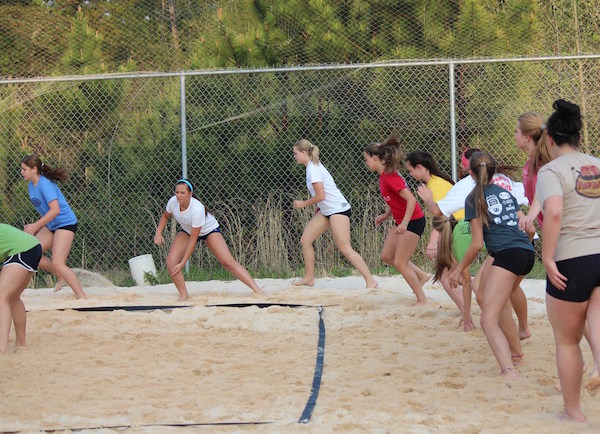Miles’s Law postulates that “where you stand depends on where you sit”. How we think about things is a composite of the sum total of our life experiences predisposing us in a particular direction. If we understand how we got to where we are today as a sport and business then we can make predictions about where we are going in the future. Since we are a young industry we can learn from how other businesses in other industries evolved to forecast the path we might take.
First of all, how did we get to where we are today? In 1985, momentous legislation was passed by the federal government mandating that universities provide an equal number of athletic scholarships for both men and women. This, of course, was Title IX and it rocked the athletic world as we knew it. The combination of scholarships for women (the carrot) and the burgeoning cost of a college education (the stick) conflated to create an explosion in our volleyball world. Doors were opened for women that, theretofore, had been the sole province of the male gender.
As an adjunct to this development, colleges, armed with millions of scholarship dollars, needed an efficient way to scout players for their varsity teams. They discovered that it was much more economical for them to see twenty players on one weekend in one place than to travel the countryside to watch just one player perform on their high school team against overmatched competition.
Societal changes occurred, simultaneously, accelerating the growth of club volleyball. ESPN was born in 1979 and televised sports engendered a mammoth interest in all sports at the same time that a rising standard of living provided the means and leisure time to afford and participate in youth amateur sports like volleyball. The popularity of sand volleyball, in the Olympics, attracted millions of new fans to our sport.
The number of females playing volleyball now exceeds the number playing basketball at the AAU level. Moreover, at many universities, attendance at female volleyball games exceeds attendance for basketball games. The Big Ten and SEC television networks are televising more games each year and ESPN carries our national championships, now, at both the university and club levels.
Prediction
Our sport has never been healthier and will surpass basketball as the most popular female sport in America. Our sport will attract more girls from other sports. With this increase in popularity, more games will be televised, player endorsements will be forthcoming, agents (for better or worse) will appear and our “age of innocence” will be challenged. It will take great leadership to ensure that our sport does not take on some of the seedier elements of boys basketball. We must understand that, as with any business, if you want to predict direction you must “follow the money”. Great leadership can ensure that the girls’ best interests are held above corporate interests.
______________________________________________________________________________
What can we learn about our business from the experiences of other businesses? When you study other businesses like banks, hotels and restaurants you observe that they are consolidating nationally. This is true of most fragmented* industries as they mature. It is evolutionary and is driven by economies of scale, Darwin’s “Survival of the Fittest”, and the preference for talented people to work in larger companies that can pay higher salaries.
Lets’ study the history of the banking business to predict how our sport (business) might evolve. Each year, about 5% of all banks, nationally, are acquired or merged. When a bank is acquired, the cost of running that bank declines by about 30% because the “mother bank “assumes many of the functions the acquired bank performed. It might also install more sophisticated I.T. systems.
Prediction
So what does the banks’ experience portend for the volleyball business? It probably means that, in the future, there will be fewer and larger clubs. The more successful clubs will purchase and/or absorb nearby clubs, in some cases, converting them into satellites. The Mother Club will institute it’s training regimen and assume tasks like player administration, accounting, collections, scheduling, hiring, legal, recruiting and so forth.
There are some factors, like distance, that favor regional, smaller clubs. Who wants to drive an hour or more to a larger, more prominent club when excellent training is available to them at their hometown club? Club costs would be another factor that favors smaller, local clubs.
____________________________________________________________________________
Sand volleyball has been a hotly debated topic for awhile. As one would suspect, there is a bifurcation of sentiment regarding sand volleyball between the warm and cold weather states. States like California and Florida have inherent advantages when it comes to sand volleyball: a beach culture, twelve months of warm weather, high school teams and a large and growing pool of universities offering it as a scholarship varsity sport.
In and of itself the sport is unquestionably, popular. One only has to travel Lakeshore Drive in Chicago to observe how the sport has taken over the beach during the summer months there. Other smaller, northern cities, like South Bend, Indiana, have carved out a hugely popular adult summer sand league. In their case, it is associated with a restaurant bar.
*A fragmented industry is one that is comprised of hundreds or thousands of small businesses as opposed to say, the car business that is comprised of just four companies.
At the club level, sand volleyball is becoming a necessary component of club programming in the warm weather states. Some northern clubs like Empowered (Ft. Wayne, Indiana) and Mintonette (Columbus, Ohio) have taken a lead in sand and invested in indoor sand courts. Girls love to play the sport and clubs recognize the cross training opportunities between sand and hard courts. The irony might be that sand’s primary competition is not basketball but, hard court volleyball itself. Just how much volleyball can a young lady play? There is a precedent for a multi-court sport and that would be tennis which is played on grass, clay and hard surface.
Prediction
Sand volleyball, at the club level, will continue to grow in popularity in the warm weather states as more high schools and colleges offer the sport. The necessary infrastructure, like tournaments and camps, will support the growth of the sport. A lucrative television deal could catapult this sport to unprecedented levels.
In the cold weather states, sand will grow less rapidly and be confined to a few of the larger, better capitalized clubs who can afford the investment in sand courts.
Another dimension to the sand game is adult volleyball. I have witnessed enough to be convinced that it is an opportunity crying out to be met by entrepreneurs who will invest in the courts and programming. Volleyball clubs are positioned to take leadership in this initiative even though the bar aspect creates a cultural clash.
____________________________________________________________________________
In the end, sand volleyball will become a national sport albeit more popular in the warm weather states. In some respects it will become the mirror image of ice hockey except with much broader participation. That sums up a few of the changes that this author predicts will prevail in this sport that we love. The only constant will be change and it will be fun to be a part of this growing, exciting sport!
For related reading on the business of junior volleyball, click here. Click here to read more about the culture of volleyball.
About the Author
The author, Tim Kuzma, is an entrepreneur and registered Certified Financial Planner. He is a graduate of The University of Michigan, where he played basketball, and is, also, a part owner of The Munciana Volleyball Club.













